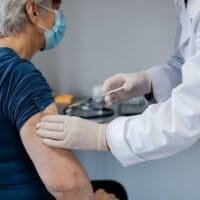COVID-19 is still the third leading cause of death in America, killing about 400 people a day, largely the unvaccinated and those 65 and older. The deaths are largely preventable since most are among unvaccinated people, epidemiologist Katelyn Jetelina writes in her newsletter, Your Local Epidemiologist.
“We are still losing an unacceptable number of Americans,” Jetelina writes. “I know it doesn’t feel like it in the news, or the grocery store, or even emergency departments, but it is happening. … We cannot accept this death toll in our society. We can do better.”
She adds that from Sept. 6 through Sept. 12, the U.S. lost 2,299 people to COVID-19, and that during August 2022 alone, 15,284 Americans died from it.
In Kentucky, the state attributed 65 deaths to COVID-19 Sept. 6-12, and in August, more than 300.
Jetelina says these numbers matter because overall death rates are not back to pre-pandemic levels, with excess deaths still 10% higher than expected, and this is changing our life expectancy. In 2020, Kentucky’s life expectancy declined a full two years, from 75.5 to 73.5, according to a national report.
Jetelina said it is “abundantly clear” that the majority of COVID-19 deaths are among the unvaccinated, and notes that 20% of Americans are still without even one dose. That rate is even higher in Kentucky. State data shows that one-third, or 33%, of the state’s total population is unvaccinated for COVID-19.
Stressing the need to be fully vaccinated and boosted, Jetelina writes, “The more vaccine doses one has, the more that person is protected from death.”
Citing the Centers for Disease Control and Prevention, she writes, “Vaccinated people with one booster had three times the risk of dying compared to people vaccinated with two boosters. Unvaccinated people had 14 times the risk of dying compared to those with two boosters.”
Another strong predictor of COVID-19 death is age. “Specifically, unvaccinated 65-plus-year-olds have by far, the highest rates of death,” she writes.
And while this age group is among the most vaccinated, Jatelina writes that 60% of them who are fully vaccinated have not had a booster shot. This is also true in Kentucky, state data shows that only 61% of the 65-74 population having received any COVID-19 boosters and only 62% of those 75 and older had.
“This needs to change,” she writes.
Most Kentucky COVID-19 deaths are in people 60 and older. From June 2021 through August 2022, after the Delta variant was dominant, 56% of Kentucky’s deaths were among those 70 and older and 35% were in those aged 50-69. Like the rest of the nation, the majority of deaths in every age group have been among those who were unvaccinated or only partially vaccinated.
Jetelina also looked at the role that health status plays in COVID-19 deaths, pointing to a University of Michigan study that found among COVID-19 patients in intensive care, about half were immunocompromised, had a significant underlying lung disease, or were over 65 — and about five out of six of the people in intensive care were under-vaccinated or unvaccinated, meaning that only one in six were up-to-date on vaccines.
This, she says, highlights the need to reduce community spread of the virus to vulnerable populations.
Jetelina is a California epidemiologist and biostatistician who says she writes the newsletter on Substack as a way to translate public-health science for everyday use, helping people to make evidence-based decisions.





